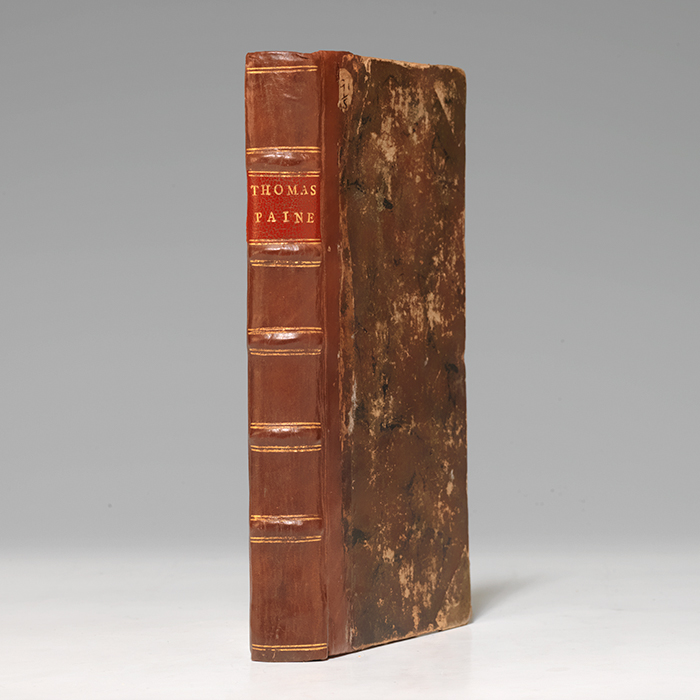
"HISTORY IS TO ASCRIBE THE AMERICAN REVOLUTION TO THOMAS PAINE" (JOHN ADAMS): FIRST EDITION OF THE GENUINE TRIAL OF THOMAS PAINE FOR THE RIGHTS OF MAN, 1792, TOGETHER IN ONE RARE VOLUME WITH THE SAME YEAR'S LONDON EDITIONS OF RIGHTS OF MAN & RIGHTS OF MAN PART THE SECOND
(AMERICAN REVOLUTION) PAINE, Thomas. The Genuine Trial of Thomas Paine, For a Libel Contained in the Second Part of Rights of Man; At Guildhall, London, Dec. 18, 1792, Before Lord Kenyon and a Special Jury: Together with the Speeches at Large of the Attorney-General and Mr. Erskine, and Authentic Copies of Mr. Paine's Letters to the Attorney-General and Others, On the Subject of the Prosecution. Taken in Short-Hand by E. Hodgson. London: Printed for J.S. Jordan, 1792. BOUND WITH: Rights of Man: Being an Answer to Mr. Burke's Attack on the French Revolution. Part I. BOUND WITH: Rights of Man; Part the Second. Combining Principle and Practice. London: H.D. Symonds, 1792. Small octavo (4-3/4 by 8 inches), contemporary marbled boards rebacked in later half brown calf, raised bands, red morocco spine label. $6500.
First edition of one of very first accounts of the infamous British trial accusing Paine of seditious libel and declaring him an outlaw for The Rights of Man, Part Two—"his most important statement of political principles" (New Yorker)—bound together with the same year's very early London editions of Rights of Man, and Rights of Man, Part Two, in contemporary boards.
"Thomas Paine wrote like no one else: he wrote for everyone… So ripping was Paine's prose, and so vast was its reach, that Adams once complained to Jefferson, 'History is to ascribe the American Revolution to Thomas Paine." Following Paine's crucial role in the Revolution, he returned to England where, in 1792, he followed the first part of The Rights of Man with "The Rights of Man, Part the Second, his most important statement of political principles, in which he explained and insisted on natural rights, equality and popular sovereignty… Paine's Second Part was outsold only by the Bible. But… Paine was charged with seditious libel and everywhere his ideas were suppressed and his followers persecuted" (New Yorker). A government campaign urged local clergy and magistrates to denounce Paine and hired spies to tail "him constantly on London's streets" (Keane, 337). Paine's friends urged him to seek refuge in exile in France, and "in September 1792, that's just what Paine did" (New Yorker).
Back in England, "the trial of Thomas Paine was unique in that the defendant was not in custody and not even within the jurisdiction of the trial court. The trial took place in London on December 18, 1792. The indictment charged Paine with the publication of a seditious libel in the form of his pamphlet entitled The Rights of Man" (Raby, 61). "Attorney-general Macdonald explained in the trial that he had not prosecuted the first part, because he thought that it would only reach the 'judicious reader.' The second had been industriously circulated in all shapes and sizes… The real reason was obvious. The respectable classes had taken alarm at the events in France…The Rights of Man was thus adopted as the manifesto of the party which sympathized with the French revolution" (DNB).
"Despite the brilliance of Paine's attorney, Thomas Erskine, Paine was found guilty, declared an outlaw and The Rights of Man contraband" (Gimbel 78). It remains "the clearest of all expositions of the basic principles of democracy" (PMM 241). Genuine Trial: first edition, published immediately after the trial; the same year as Trial at Large of Thomas Paine, no priority established. Precedes the first American edition. Collates (ii), 32,*33-*37, (blank), [Defence] 33-109, (1). With press figures: 6-I, 13-2, 18-I, 26-2, 34-I, 40-8, 48-4, 52-7, 65-I, 66-8, 74-7, 82-8, 105-0. Without final advertisement leaf. Rights of Man Part I was first published in February 1791 by London publisher Johnson, but was immediately suppressed. The same year, with difficulty, Paine was able to secure another London publisher, J.S. Jordan. This 1792 Symonds edition, also issued in London, is preceded by the same year's first Symonds edition (issued without press figures). Collates: (iv), 78. With press figures 10-3, 45-3, 47-3, 71-2, 72-4. Rights of Man Part the Second was originally published by J.S. Jordan in February 1792. This early 1792 Symonds edition contains title page with "Price Sixpence" in square brackets on title page; notes set in small type; catchword "abilities" correctly used (40); 4 lines of text preceding note (53); page 91 numbered; last line to second page of Appendix reading "are now at." With press figures: 38-4, 82-2. Collates: (2) (vii), (8-9), 10-91 [Appendix] (3); without rear advertisement leaf. Occasional mispagination without loss of text. Publisher Symonds would be prosecuted, sentenced to jail time and fined for publishing, the same year, Paine's Letter Addresses to the Addressers. Trial: Sabin 96910. ESTC T5894. Gimbel-Paine, 125. Rights Part I: See Gimbel-Paine, 91-2, 101; Gimbel-Yale 69; ESTC T5878; Howes P-31. Rights, Part II: Gimbel-Paine 106-108, Gimbel-Yale 69. ESTC T5879. Early owner signature inscribed "London 1826."
Text fresh with only lightest scattered foxing, slight rubbing to contemporary boards. An extremely good copy of these core Revolutionary works.